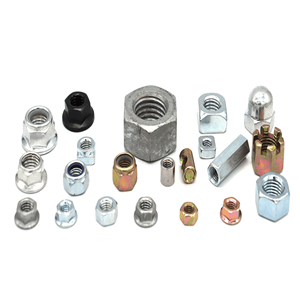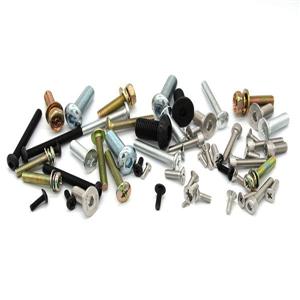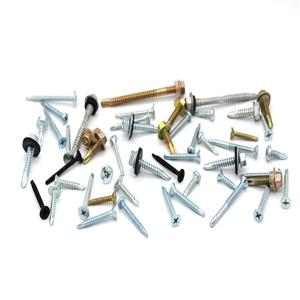Hydrogen embrittlement of alloy steel bolts (3)
5 Technical ways to prevent hydrogen embrittlement fracture of alloy steel bolts
Prevention of hydrogen embrittlement fracture of alloy steel bolts requires comprehensive consideration based on the mechanism of hydrogen embrittlement fracture. According to the required tensile strength, select the appropriate material and the corresponding manufacturing process. 6.1 Selection of MJ threaded bolts Selection of MJ threaded bolts can not only improve the bolt's ability to withstand dynamic loads, but also improve the bolt's ability to resist hydrogen embrittlement. Reducing the stress concentration plays an important role in reducing the susceptibility of bolts to hydrogen embrittlement. Therefore, when selecting bolt threads, try to use MJ threads with a larger arc radius at the bottom of the thread. The bottom arc radius of MJ thread is in the range of 0.15042P~0.18011P, which is much larger than the bottom arc radius of ordinary bolt thread of 8.8 or higher (greater than or equal to 0.125P), and any transition parts (including The transition section at the end of the thread must be smoothly transitioned. This is of great benefit for reducing the stress coefficient of the thread, thereby reducing the susceptibility of the thread to hydrogen embrittlement.
The processing technology of MJ threaded bolts has three characteristics: ①The thread must be rolled into shape after the final heat treatment; ②The bolt head must be upset and shaped; ③The lower fillet of the bolt head must be cold rolled after the final heat treatment. These processing techniques can effectively eliminate material defects on the surface of the bolt and increase the residual compressive stress on the surface of the bolt. As a result, it can play a significant role in reducing the hydrogen embrittlement sensitivity of the bolt.
5.2 Choose reasonable processing technology and adopt strict preventive measures
Since the critical value of tensile strength for hydrogen embrittlement fracture is 1050 MPa, for bolts whose strength level is below 1000 MPa, regardless of whether they are electroplated or not, hydrogen embrittlement is not considered. For alloy steel (such as 30CrMnSiA) bolts with a tensile strength above 1000 MPa, as long as the normal heat treatment, electroplating, and hydrogen removal processes are used in accordance with the requirements of relevant standards, hydrogen embrittlement can be completely avoided.
In order to reduce the degree of hydrogen permeation and improve the effect of hydrogen removal, measures need to be taken from the following aspects.
5.2.1 Heat treatment
Tempered martensite has a greater impact on the sensitivity of hydrogen embrittlement, so the heat treatment temperature can be adjusted appropriately during heat treatment to reduce the formation of tempered martensite. For example, the use of austempering will increase the threshold of hydrogen embrittlement fracture by about 100 MPa. This is because the lower bainite structure produced by austempering is less sensitive to hydrogen embrittlement than tempered martensite.
Sometimes shielding gas is added to the heating furnace to prevent the formation of oxide scale on the parts. However, if the protective gas contains hydride (such as methanol cracking gas, RX gas, etc.), the hydride will be decomposed into hydrogen after heating, which will cause hydrogen permeation and increase the risk of hydrogen embrittlement. Therefore, it is not advisable to use protective gas containing hydride in the heat treatment process. If conditions permit, it is best to use a vacuum furnace for quenching and tempering.
According to the aerospace industry standard QJ 451-1988 "Quality Control Technical Requirements for Parts (Parts) Before Plating", all parts with a tensile strength greater than 1050MPa but less than or equal to 1450MPa should be subjected to stress relief treatment, and the specific heating temperature is 190℃ ~210℃, time is 1 h. The stress here refers to the residual tensile stress caused by the heat treatment, and should not include the residual compressive stress caused by the rolled thread or the rounded corner of the cold rolled head after treatment.
5.2.2 Pickling
Although pickling is not the main process of hydrogen permeation, if it is not well controlled, hydrogen permeates into the bolts. Therefore, many standards emphasize the prohibition of pickling with strong acid before plating, and the use of weak acid pickling or shot peening instead.
5.2.3 Electroplating
Electroplating is the main process for bolts to absorb hydrogen, and strict control of the electroplating process is the main measure to prevent hydrogen embrittlement of bolts.
Choosing different electroplating processes according to the tensile strength of bolts is one of the means to avoid hydrogen embrittlement fracture. For 30CrMnSiA bolts with a tensile strength above 1080MPa, ordinary zinc plating or cadmium plating can be used.
For alloy steel bolts with tensile strength above 1250MPa, although ordinary zinc or cadmium plating processes can also be used, more stringent process control must be adopted. ISO 5857:1988 "Aerospace Strength Grade 1250MPa MJ Threaded Alloy Steel Protruding Head Bolts Procurement Specification" stipulates that product bolts should undergo a stress endurance test, that is, 75% of the minimum breaking tensile load is applied to the bolts for 23 hours, and the bolts shall not break. Or destroy. GB/T 3098.1-2010 "Mechanical Properties of Fasteners Bolts, Screws and Nuts" reminds users that they should be cautious when considering the use of bolts of grade 12.9 or above. It is necessary to carefully consider whether electroplating will cause stress corrosion fracture (hydrogen embrittlement fracture) of the bolt from various aspects such as the manufacturing capacity of the fastener, the service condition and the tightening method (installation process).
According to the "Prohibited (Limited) Process Catalog for Aerospace Products" (see Tian Technology [2004] No. 42), for bolts with a tensile strength above 1300 MPa, zinc or cadmium electroplating is not allowed, but low hydrogen embrittlement electroplating can be used. Craft. Low hydrogen embrittlement electroplating is a type of process developed for the hydrogen embrittlement of aircraft parts in the 1960s and 1970s, including low hydrogen embrittlement cadmium plating, low hydrogen embrittlement cadmium titanium plating, and low hydrogen embrittlement zinc nickel plating. Low hydrogen embrittlement electroplating requirements: stress relief tempering before plating, sandblasting instead of pickling, or vacuum heat treatment. In the electroplating process, on the one hand, the bath formulation is adjusted, and on the other hand, the voltage is reduced to strictly control the current density to reduce hydrogen absorption.
Cadmium-plated titanium is a set of low-hydrogen embrittlement electroplating process formed by reforming, improving, and improving the similar processes in foreign countries in the last century. Titanium has a strong adsorption effect on hydrogen. It can adsorb hydrogen on the surface of the product and prevent hydrogen from penetrating into the substrate. Therefore, low hydrogen embrittlement cadmium-plated titanium has made great contributions to solving the problem of hydrogen embrittlement, and it is still widely used in the aviation industry. . However, it is rarely used in the aerospace industry because of its strict process operation and high cost, and basically no production line has been established.
In the aerospace industry, the low hydrogen embrittlement zinc-nickel alloy plating process and the low hydrogen embrittlement cadmium plating process have been carried out in a small range in the 1980s, and the aerospace industry industry standard QJ 1824-1989 "Zinc-nickel alloy coating technical conditions ", QJ 2217-1992 "Low Hydrogen Embrittlement Cadmium Process Specification".
Of course, for bolts with a tensile strength above 1500 MPa, low hydrogen embrittlement plating is also risky. Hydrogen embrittlement fracture occurs from time to time. If you want to completely avoid the risk of hydrogen embrittlement, you can use a non-hydrogen embrittlement coating process, or change it. Use other corrosion-resistant materials.
In addition, in accordance with the provisions of ISO 9587 "Metal and other inorganic coatings to reduce the risk of hydrogen embrittlement steel products pretreatment", bolts should be subjected to stress relief treatment before electroplating.
5.3 Hydrogen removal
Hydrogen removal is to put the bolts in an oven at about 200°C for baking, so that the hydrogen in the bolts is combined into hydrogen molecules and escapes. The key to improving the effect of hydrogen removal is: first, remove hydrogen in time after plating; second, keep the temperature of hydrogen removal as high as possible; third, the time for hydrogen removal should be long enough.
Timely removal of hydrogen after plating has a great influence on improving the effect of hydrogen removal. The general standard stipulates that no more than 4 hours after plating, and some foreign enterprise standards stipulate that hydrogen should be removed within 3 hours. In fact, many companies have compressed the time interval between electroplating and hydrogen removal to less than 1 hour in order to improve the effect of hydrogen removal.
The higher the hydrogen removal temperature, the better the hydrogen removal effect, but it cannot approach or reach the tempering temperature of the material, otherwise the performance of the material will be affected.
The hydrogen removal time should be different according to the strength of the bolt. The higher the strength, the longer the hydrogen removal time is required. According to relevant standards (such as QJ 452), the hydrogen removal temperature of 30CrMnSiA bolts should be 190℃~210℃, and the hydrogen removal time should be no less than 8h.
It should be noted that if the hydrogen removal time is too short, not only will it not help reduce the hydrogen content, but will increase the hydrogen content. Figure 9 shows the relationship between the hydrogen removal time and the embrittlement rate of parts after plating in different baths. It can be seen from Fig. 9 that the embrittlement rate for 2h~4h of hydrogen removal is higher than that without hydrogen removal. This is because the hydrogen concentration absorbed by the surface layer of the part is the largest after the electroplating. At the beginning of baking, the hydrogen adsorbed on the surface quickly diffuses and overflows into the air on the one hand, and accelerates to diffuse into the metal on the other hand. When the internal and external concentration balance of the material is reached or the internal concentration is higher than the surface concentration, hydrogen begins to diffuse outward.
image
5.4 Coating without hydrogen embrittlement
The use of hydrogen embrittlement-free coating technology is a technology to completely avoid hydrogen embrittlement. From the 1960s to the 1980s, the United States, Germany, France, Japan and other countries developed some coatings without hydrogen embrittlement. These coatings do not need to adopt cathodic electrodeposition, and there is no hydrogen absorption process, so they are called "non-hydrogen embrittlement coatings". They can be used for bolt coatings such as mechanical galvanizing, powder sherardizing, dacromet coating, etc. At present, the most widely used Dacromet coating should be.




